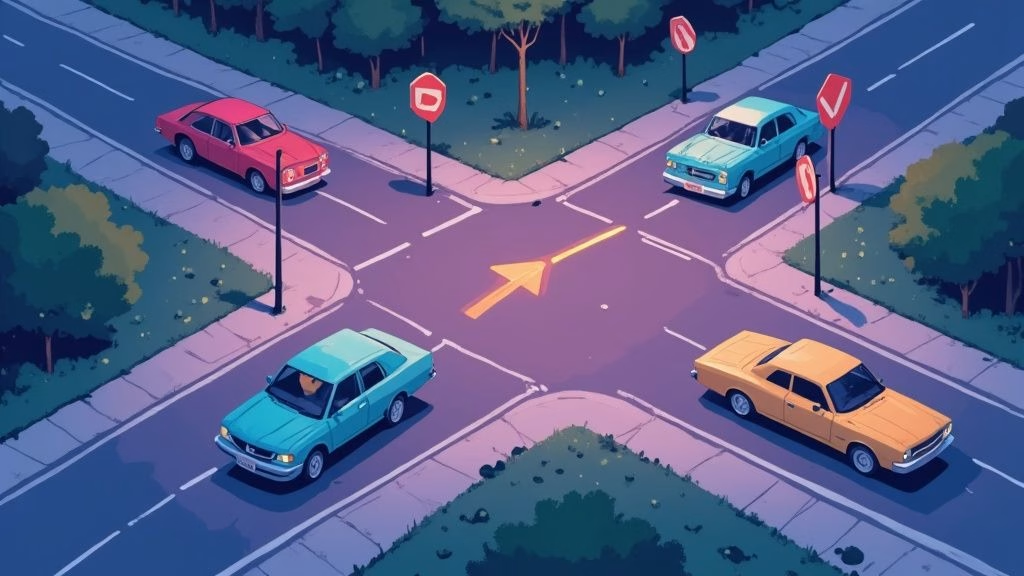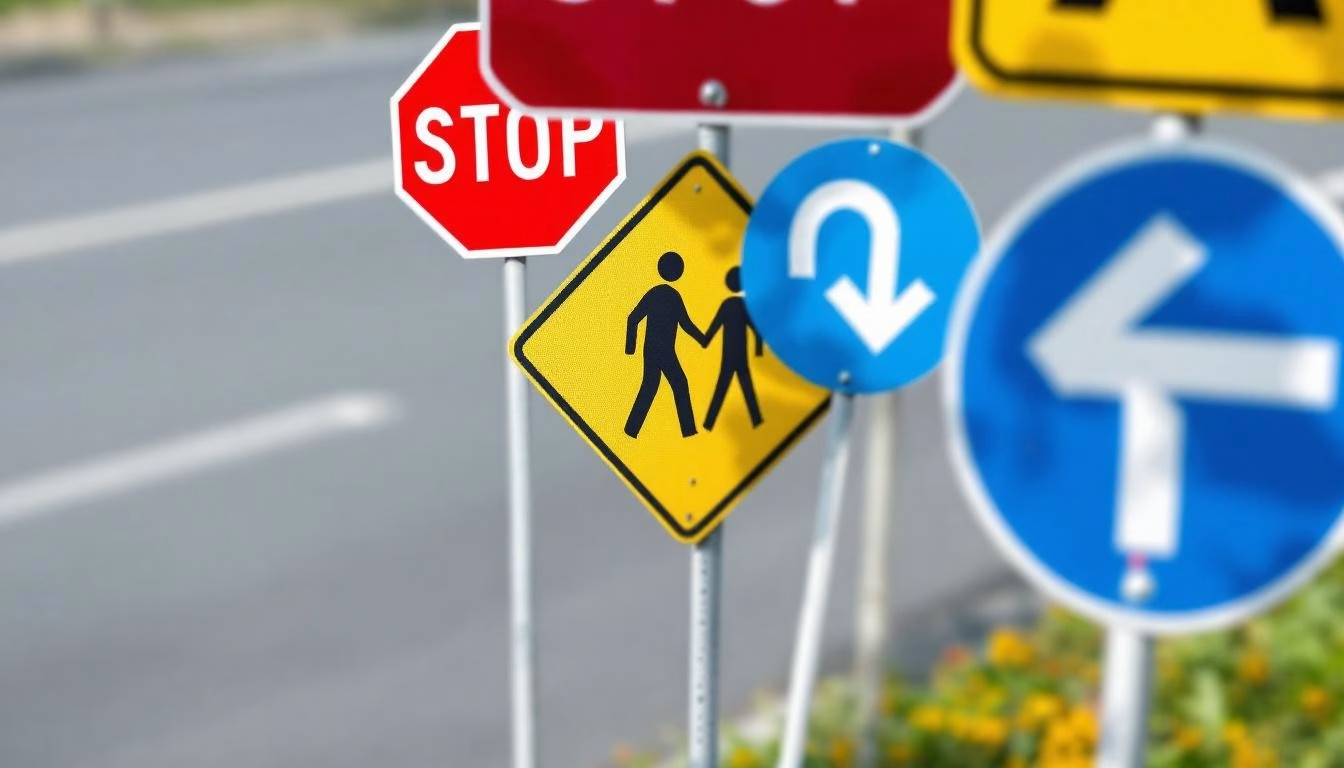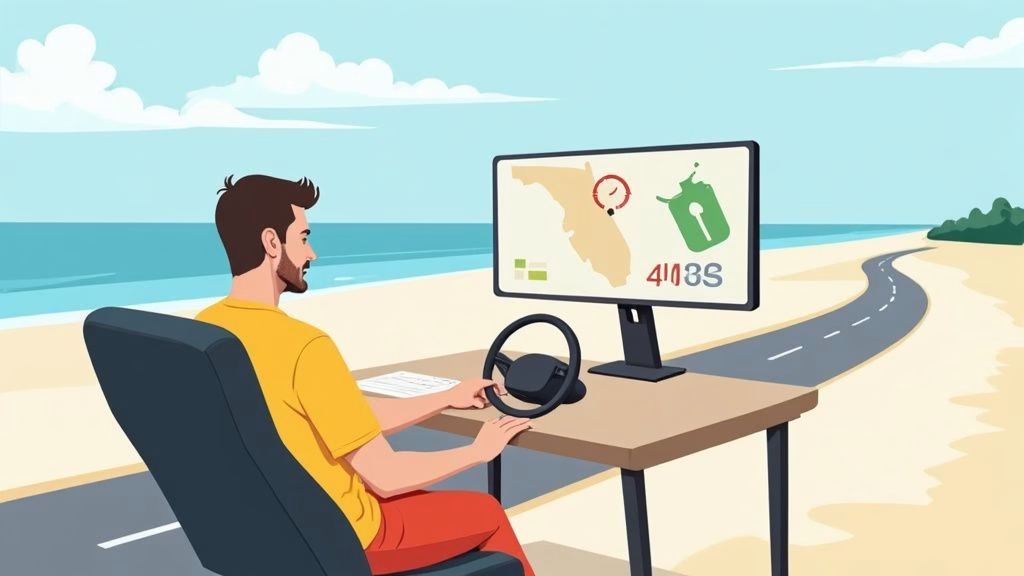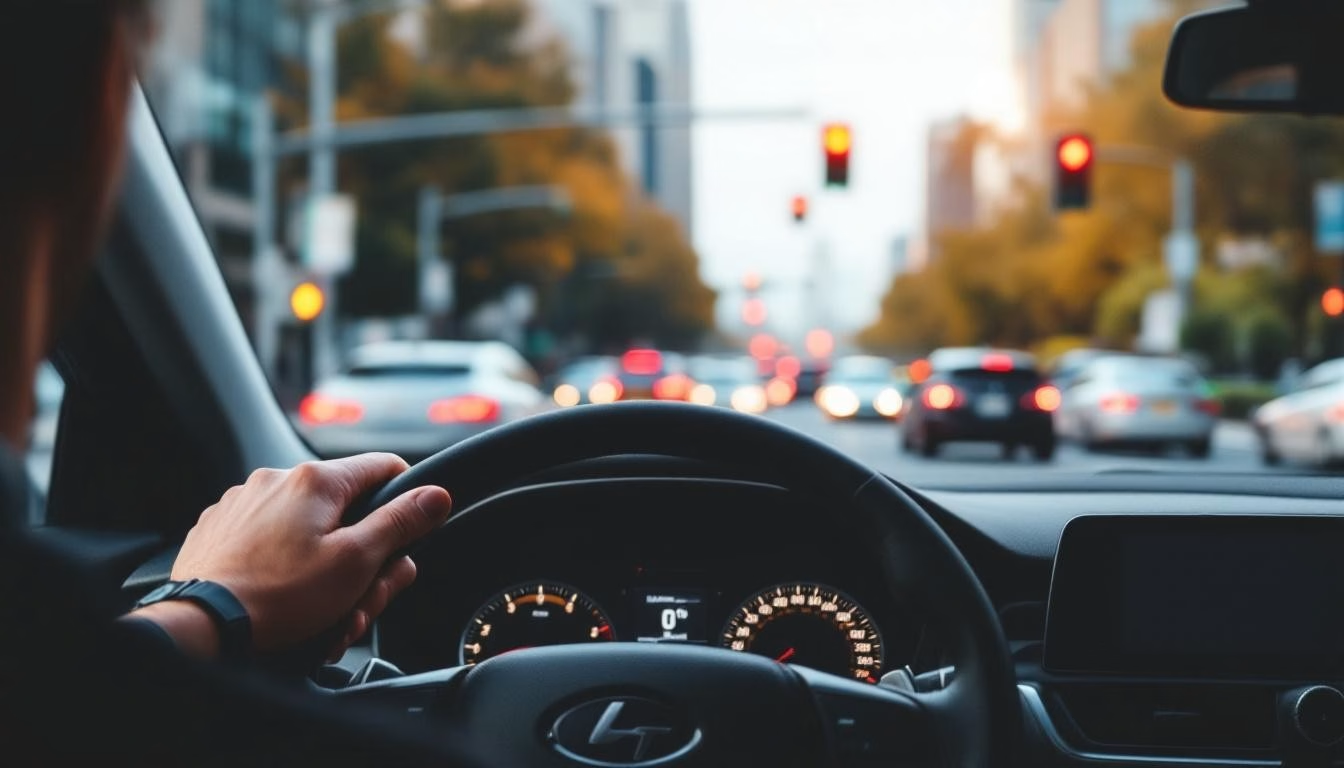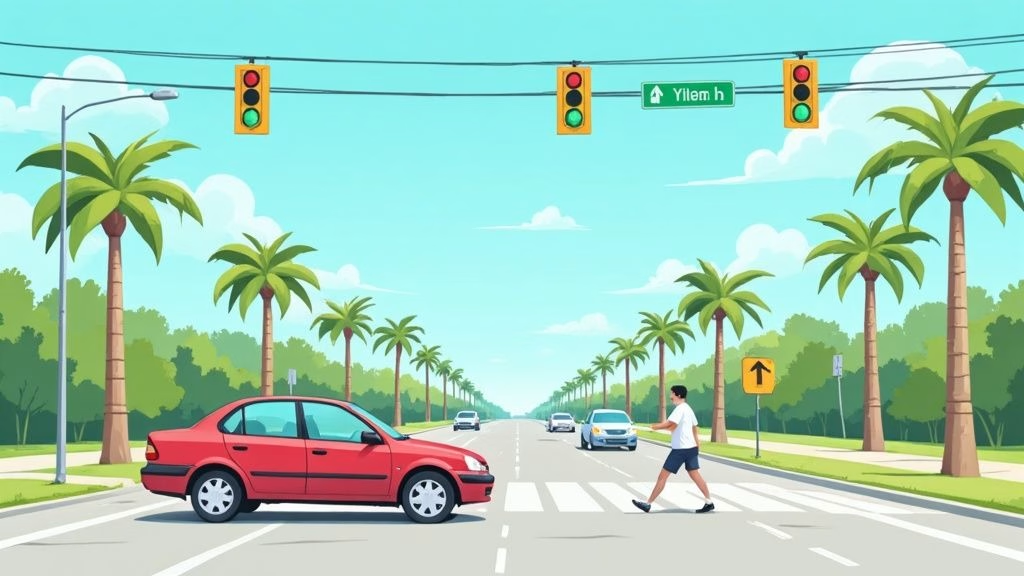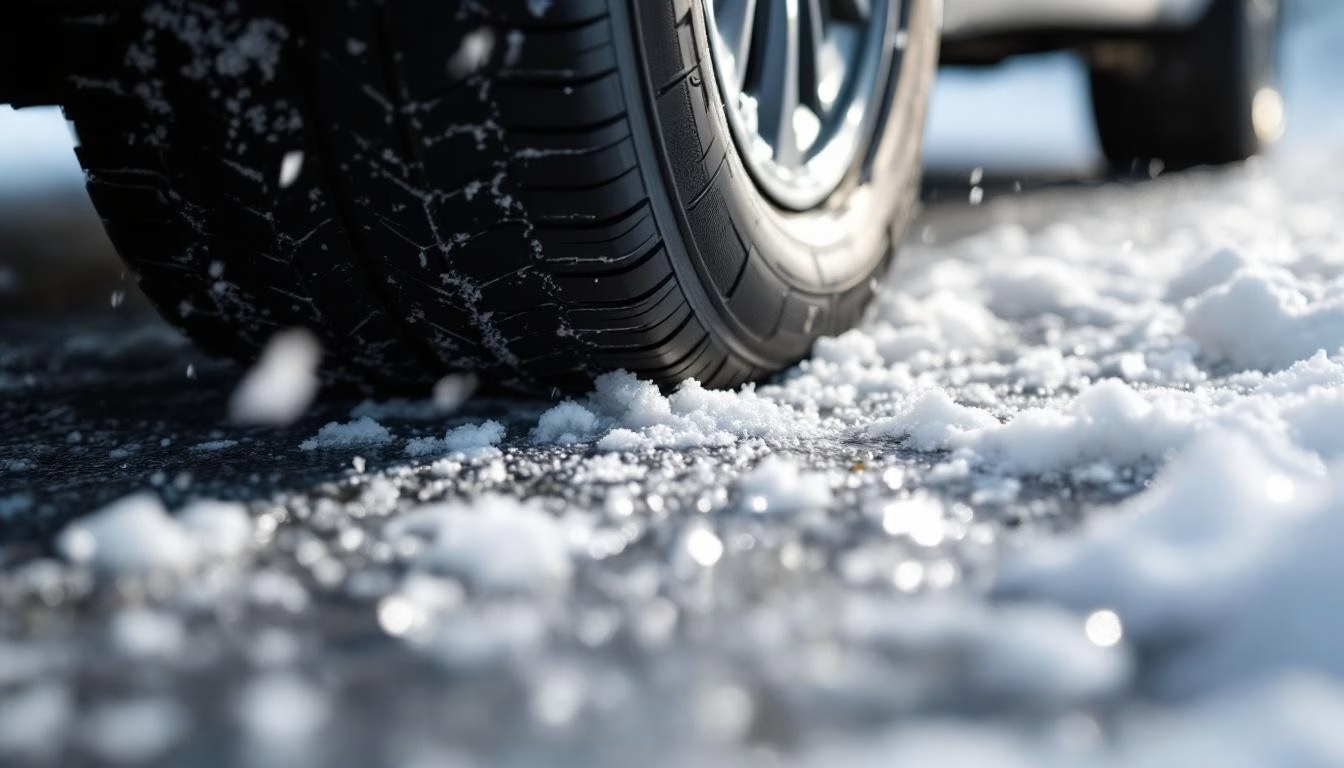The golden rule of any four way stop is beautifully simple: the first vehicle to get there and make a complete stop gets to go first. Think of it like a polite, first-come, first-served system that keeps traffic moving in a safe and predictable rhythm.
But what happens when two cars pull up at the exact same moment? The rule is just as clear: the driver on the right has the right-of-way.
Decoding the Four Way Stop

Let’s be honest, pulling up to a busy four-way stop can feel like a complex dance, especially when multiple cars arrive at nearly the same time. That moment of hesitation�”Do I go? Do they go?”�is something every driver has felt. That uncertainty can lead to confusion and, in the worst cases, an accident.
Fortunately, these intersections operate on a clear and logical hierarchy designed to bring order to potential chaos. The whole point is to replace doubt with a predictable system. Once you get a handle on a few core principles, you can approach any four-way stop with confidence, knowing exactly when it’s your turn to go.
A System Built for Safety
There’s a good reason why four-way stops are so common: they work. Their design forces every single driver to slow down, come to a complete stop, and actually look at their surroundings before proceeding. This simple act of pausing is a game-changer, dramatically reducing the potential for dangerous, high-speed collisions.
The impact these intersections have on road safety is massive.
A case study by the U.S. Federal Highway Administration found that intersections controlled by stop signs saw about a 55% reduction in total crashes and a staggering 70% reduction in total injuries each year.
The Power of the Turn Signal
Knowing the right-of-way rules is only half the battle. The other half is communication. Using your turn signal long before you even reach the intersection is one of the most important things you can do. It tells every other driver exactly what you plan to do, which removes all the guesswork.
For a deeper dive into this critical driving habit, check out our guide that explains exactly when to use turn signals for maximum safety and clarity. It’s a simple action that keeps traffic flowing smoothly for everyone.
The First to Arrive, First to Go Principle

At its core, a four-way stop runs on a simple, fair system. The most fundamental of all four way stop rules is “First to Arrive, First to Go.” This single principle is the bedrock that prevents chaos, creating a predictable and safe flow of traffic where there are no traffic lights.
Think of it like getting in line at the grocery store. The person who gets to the checkout first is the one who gets served first. A four-way stop works the exact same way. Whichever driver reaches the intersection and makes a complete stop before anyone else gets to go first.
This rule is beautifully straightforward. It cuts through the confusion, regardless of which direction you’re coming from or which way you intend to turn. If you were the first car to stop, the right-of-way belongs to you.
What �Complete Stop� Really Means
The whole system falls apart without one critical action: the complete stop. This isn�t a friendly suggestion; it�s a legal requirement and the linchpin that makes the entire intersection function. A real stop means your wheels have completely stopped turning and your vehicle�s speed is at 0 mph.
It’s tempting for drivers to do a “rolling stop,” where the car slows way down but never actually ceases all forward movement. This is not only illegal but also incredibly dangerous because it throws a wrench into the whole system. Other drivers are left guessing, “Did they stop? Are they going?” This ambiguity shatters the clear, turn-based order.
A driver who fails to stop completely essentially loses their spot in line. They create confusion that causes other drivers to hesitate or, even worse, leads to a crash if someone else proceeds, assuming the rolling driver was going to wait their turn.
Why This Rule Is So Important
Once you get the “First to Arrive, First to Go” rule down, navigating these intersections becomes second nature. It�s no longer a guessing game of trying to read another driver�s mind. Instead, it�s just a simple matter of observing who got there when.
Here�s the simple process to follow every single time:
- Observe: As you approach, pay attention to the other cars. Note the order in which they arrive at their stop lines.
- Stop: Bring your vehicle to a full and complete stop behind the thick white line.
- Wait: Let any vehicles that stopped before you go through the intersection.
- Go: When your turn comes, check to make sure the coast is clear and then proceed with caution.
By sticking to this foundational rule, you make your actions easy for others to predict, and their actions become predictable to you. It’s this shared understanding that keeps four-way stops from becoming a free-for-all.
Solving the Simultaneous Arrival Puzzle
The “First to Arrive, First to Go” rule is the bedrock of four-way stops, but what happens when things aren’t so clear-cut? The real test for drivers comes when two, three, or even four cars pull up to their stop lines at the exact same moment. This is where you see the classic hesitant dance, but there’s a simple set of tie-breaker rules to clear up the confusion.
When arrival time is a tie, the next rule in the pecking order takes over: yield to the vehicle on your right.
This is the golden rule for breaking a stalemate. If you and another driver arrive at the same time, and that driver is on your right, they have the right-of-way. It’s your job to wait until they’ve cleared the intersection before you proceed.
The Clock Face Analogy
Having trouble visualizing the “yield to the right” rule? Try picturing the intersection as a clock face.
Let’s say you’re at the bottom, in the 6 o’clock position. A car that arrives at the same time as you at the 9 o’clock position (to your right) gets to go first. On the other hand, a car at the 3 o’clock spot (your left) has to yield to you.
This mental trick works no matter which direction you’re approaching from. It helps establish a predictable, counter-clockwise flow of traffic, allowing the intersection to clear out smoothly and safely.
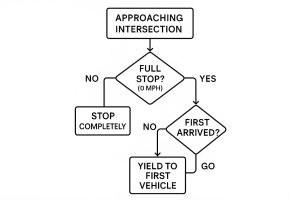
This simple diagram shows how the “yield to the right” rule is the go-to tie-breaker right after you’ve determined who arrived first.
Solving Simultaneous Arrival Scenarios
When multiple cars arrive at the same time, things can feel a bit more complex. The table below breaks down the common scenarios you’ll encounter and clarifies who has the right-of-way based on established traffic rules.
| Situation | Who Goes First | Governing Rule |
|---|---|---|
| Two cars arrive at adjacent signs. | The driver on the right. | Yield to the vehicle on your right. |
| Two cars arrive at opposite signs, both going straight. | Both can proceed at the same time. | Paths do not cross; safe to proceed with caution. |
| Two cars arrive at opposite signs; one is turning left. | The driver going straight. | Left-turning traffic must always yield to oncoming traffic. |
| Two cars arrive at opposite signs; one turns right, one turns left. | The driver turning right. | A right turn is a simpler maneuver and does not cross a traffic lane. |
Remembering these specific interactions helps take the guesswork out of navigating even the busiest four-way stops. It all comes down to a clear hierarchy of rules.
The Rare Four-Car Gridlock
It’s not something you see every day, but it’s possible for cars to pull up to all four stop signs at once. So, who goes? Technically, there isn’t a specific traffic law that covers this exact deadlock. This is where communication and common sense become more important than any rule in the book.
In these situations, one driver usually breaks the stalemate by making a hand gesture to yield to another, which starts a domino effect. The best thing you can do is be patient, make eye contact, and use clear hand signals to show your intentions. Once that first driver goes, the standard “yield to the right” rule can untangle the rest.
Navigating these edge cases with confidence is a huge part of being a safe driver. If you ever feel rusty, it’s never a bad idea to brush up on defensive driving techniques to stay sharp on the road.
Sharing the Road: Pedestrians, Cyclists, and Other Vehicles
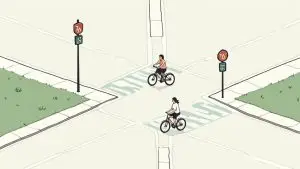
The standard four-way stop rules give us a clear pecking order for cars, but let’s be honest�intersections are rarely that simple. Out in the real world, you’re not just dealing with other drivers. You’re sharing the road with people on foot, on bikes, and even special vehicles that play by a different set of rules.
This is where true situational awareness comes in. It�s about more than just knowing who got to the stop line first; it’s about seeing the entire picture.
The single most important rule to burn into your memory is that pedestrians in a crosswalk have absolute priority. I can’t stress this enough. It doesn�t matter if you arrived first or whose “turn” it is. If someone is in or even just about to step into that crosswalk, you stop. You wait. You yield until they are safely across.
This same principle applies to cyclists. While they generally follow the same traffic laws as cars, they are incredibly vulnerable. Always give them the right-of-way and plenty of space, especially when they’re using a crosswalk to cross the intersection.
Always Yield to Vulnerable Road Users
A good defensive driver is constantly scanning, looking for more than just headlights and bumpers. Before you even think about moving your foot from the brake to the gas, you need to be actively looking for people.
Here�s a quick mental checklist to run through every single time you pull up to a stop:
- Look Left, Right, and Left Again: Scan the sidewalks on both sides for anyone who looks like they’re about to cross.
- Check for Cyclists: Pay special attention to bike lanes and the shoulder of the road. Bicycles can approach much faster than you might think.
- Try to Make Eye Contact: This is a simple but powerful tool. A quick nod or glance confirms you see each other and that you’re waiting for them to cross.
- Wait Patiently: Never, ever inch forward or try to rush someone. Give them the time and space to clear your vehicle’s path completely before you proceed.
Remember, your turn in line is always less important than someone’s safety. Failing to yield to a pedestrian or cyclist isn’t just rude�it’s incredibly dangerous and comes with serious legal penalties.
When Other Vehicles Override the Rules
Beyond people walking and biking, a few types of vehicles can completely override the first-come, first-served system. When you see them, the normal right-of-way rules go out the window.
Emergency Vehicles
If you see flashing lights or hear a siren�whether it’s a police car, ambulance, or fire truck�all standard four-way stop rules are off. Your only job is to yield. If you can, pull over to the right and stop, giving them a clear and unimpeded path through the intersection.
Funeral Processions
A funeral procession has the right to stay together. Once the lead vehicle has legally entered the intersection, the cars following it are allowed to proceed without stopping. Don’t be the person who tries to cut through or break up the line. Be respectful, be patient, and let them pass.
For a deeper dive into these unique situations, you can learn more about the broader principles in our guide on who has right-of-way.
Large Commercial Trucks
A big rig or city bus doesn’t get automatic priority, but they do require your respect and a lot of extra space. They need much more room and time to get moving and make turns. The safest�and most courteous�thing you can do is give them that room. Their slow acceleration and wide turns mean a little patience from you goes a long way toward keeping everyone safe.
Why Four-Way Stops Are a North American Staple
If you’ve ever driven outside of North America, you’ve probably noticed something missing from the intersections: the humble four-way stop. It�s a cornerstone of traffic control in the United States and Canada, but it�s a genuine rarity in many other parts of the world, especially across Europe.
This isn’t just a random quirk; it reflects a deep-seated difference in how we approach traffic flow and driver responsibility. The North American system is built around a simple, almost democratic principle: everyone stops. This mandatory pause forces drivers to look around, assess the situation, and then proceed in a clear, turn-based order. It’s methodical, predictable, and works well in residential neighborhoods or intersections with moderate traffic.
Different Strokes for Different Roads
Hop across the Atlantic, and you’ll find a completely different philosophy. Many European countries design their intersections to keep traffic moving whenever possible. Think of the endless flow of a roundabout or the yield-based logic of priority-to-the-right junctions. These systems prioritize momentum over full stops, aiming for a slow but continuous stream of cars rather than the constant stop-and-go of an all-way stop.
You’ll find four-way stops are common in North America but far less frequent in Europe. The UK, for instance, formally prohibited them back in 2002, favoring roundabouts instead. This Wikipedia overview on all-way stops dives deeper into these global traffic differences.
This stark contrast is exactly why understanding local four way stop rules is so critical for any driver. Someone used to the constant motion of European roundabouts might be caught off guard by the need to come to a complete halt and wait their turn.
It’s a two-way street, too. Just as learning how to navigate roundabouts is a vital skill for American drivers traveling abroad, mastering the four-way stop is non-negotiable for visitors driving here.
Ultimately, neither approach is inherently superior. They’re just different tools for the same job: making intersections as safe and efficient as possible. The four-way stop’s popularity here just happens to be built on a foundation of deliberate pauses and a well-defined system for taking turns.
Common Questions About Four-Way Stops
Even with a solid grasp of the basics, real-world driving can throw some curveballs at a four-way stop. A moment of hesitation or confusion is all it takes to create a risky situation. This section tackles the most common questions drivers have, giving you clear answers for navigating those tricky “what-if” moments.
Think of this as your quick-reference guide for the situations that don’t fit neatly into the “first-to-arrive” or “yield-to-the-right” boxes.
What if Another Driver Waves Me Through?
It happens all the time. You pull up to the stop, you know it’s the other driver’s turn, but they give you a friendly wave to go ahead. It feels like the polite thing to do, but it can inject a dangerous dose of unpredictability into the intersection. The rules exist for a reason�to create a predictable pattern everyone understands.
When someone waves you through, they’re breaking that pattern. Another driver at the stop, expecting the waving person to go, could easily be surprised when you pull out instead.
The best and safest move is to politely decline. A simple shake of the head or a hand gesture signaling them to take their turn is perfect. Sticking to the established four-way stop rules is always the safest bet, even if it feels a little less courteous in the moment.
How Should I Handle Aggressive Drivers?
Sooner or later, you’ll meet a driver who decides the rules don’t apply to them. They might roll through the stop sign or just cut in front when it’s clearly your turn. It’s frustrating, for sure. But your number one job is to stay safe.
Never escalate. If an aggressive driver jumps the line, just let them go. Your safety is worth more than being “right.” Trying to challenge them or force your right-of-way is a recipe for a collision.
When you see an impatient or aggressive driver, here�s what to do:
- Stay Calm: Don’t let their actions provoke an angry reaction from you.
- Yield Space: Give them plenty of room to get through, even when they’re in the wrong.
- Avoid Engagement: Skip the eye contact, honking, or angry gestures. It won’t help.
- Proceed Safely: Once they’re completely out of the way, re-check the intersection and then take your turn.
Is Eye Contact a Reliable Signal?
Making eye contact with other drivers is a great habit, but think of it as a confirmation, not a green light. It�s a good way to verify that another driver sees you, but it’s not a legally binding contract and can easily be misread.
For instance, a driver might glance your way but not truly register that you’re there and about to move. If you rely only on a quick look to decide it’s safe to go, you’re taking a big risk.
Use eye contact as just one tool in your situational awareness toolkit. Combine it with observing the car’s position, checking for turn signals, and�most importantly�following the actual right-of-way rules. This multi-layered approach means you�re making decisions based on clear protocols, not just a hopeful glance.
Ready to become a safer, more confident driver and handle any traffic situation with ease? The online courses at BDISchool provide all the knowledge you need, from mastering intersections to understanding Florida traffic laws, helping you dismiss tickets and lower your insurance rates. Enroll in a state-approved course today!

